Rare Rides: The Jaguar XJR-15 You've Never Seen Before

We’re having a Jaguar kick in the Rare Rides series, and by that I mean two cars in a row from the leaping cat.
Though most everyone’s heard of the XJ220, fewer are likely aware of its predecessor: the XJR-15. It’s not slow, it isn’t cheap, and it’s not luxurious.
You want it!
The genesis of the XJR-15 started back in the late 1980s, when Jaguar was winning races at Le Mans with the stunning XJR-9. Racing enthusiasts with deep pockets were impressed with the XJR-9’s performance and pushed Jaguar to develop a civilian road-going version. Any car company has a hard time ignoring potential customer requests when said customer is the Sultan of Brunei. Development was well underway by 1988. The intention from the beginning was to create a race car for the road, much like the Jaguar D-Type and Ford’s GT40.
Responsibility for building the new car (like the XJR-S) was handed to Jaguar Sport, with production beginning in late 1990. The XJR-9 was widened, made taller, and broadly altered to comply with British regulations for use as a road car. The XJR-15’s resulting construction was entirely from carbon fiber, making it the world’s first carbon fiber road car.
The naturally aspirated V12 engine used was Jaguar’s 6.0-liter mill, modified to produce 450 horsepower and 420 foot-pounds of torque. Sixty miles an hour arrived in 3.2 seconds, and the top speed was a blistering 191 miles per hour.
All this performance was part of the two-fold goal for the XJR-15: In addition to pleasing its owners, it was also intended to compete at a race series. The series in question was the 1991 Jaguar Sport Intercontinental Challenge. It was a single-model three-race event, in support of Formula One Grand Prix races taking place at Monaco, Silverstone, and Spa-Francorchamps.
Sixteen XJR-15’s entered each race, and the majority of owners hired professional drivers to pilot them around the track. Included in the nearly $1 million purchase price was prep and maintenance at the races by the JaguarSport race team. The third race in the series (Spa) carried a $1 million cash prize, which was awarded to racing driver and owner Armin Hane.
Production of the XJR-15 continued into 1992, with a total of 53 examples produced. The next racer produced by Jaguar would be it’s last; the XJ220 started production in 1992 and continued through 1994. After the commercial failure of the XJ220, Jaguar withdrew from motorsport racing.
But the unfortunate end of Jaguar’s racing was not the end for the XJR-15. Nissan approached Jaguar Sport partner TWR about developing the R390 race car. Ever resourceful, TWR used the middle of the XJR-15 (cockpit and greenhouse) for the R390. The soul of the XJR-15 got to go Le Mans racing after all; all four Nissan R390s placed in the top 10 at Le Mans in 1998.
Today’s Mauritius Blue beauty is for sale in London; buy at a price that is only available upon request. Safe bet it has six figures.
[Images via dealer, Wikipedia]

Interested in lots of cars and their various historical contexts. Started writing articles for TTAC in late 2016, when my first posts were QOTDs. From there I started a few new series like Rare Rides, Buy/Drive/Burn, Abandoned History, and most recently Rare Rides Icons. Operating from a home base in Cincinnati, Ohio, a relative auto journalist dead zone. Many of my articles are prompted by something I'll see on social media that sparks my interest and causes me to research. Finding articles and information from the early days of the internet and beyond that covers the little details lost to time: trim packages, color and wheel choices, interior fabrics. Beyond those, I'm fascinated by automotive industry experiments, both failures and successes. Lately I've taken an interest in AI, and generating "what if" type images for car models long dead. Reincarnating a modern Toyota Paseo, Lincoln Mark IX, or Isuzu Trooper through a text prompt is fun. Fun to post them on Twitter too, and watch people overreact. To that end, the social media I use most is Twitter, @CoreyLewis86. I also contribute pieces for Forbes Wheels and Forbes Home.
More by Corey Lewis
Latest Car Reviews
Read moreLatest Product Reviews
Read moreRecent Comments
- Ajla A union fight? How retro 😎
- Analoggrotto Finally, some real entertainment: the Communists versus the MAGAs. FIGHT!
- Kjhkjlhkjhkljh kljhjkhjklhkjh *IF* i was buying a kia.. (better than a dodge from personal experience) .. it would be this Google > xoavzFHyIQYShould lead to a 2025 Ioniq 5 N pre-REVIEW by Jason Cammisa
- Analoggrotto Does anyone seriously listen to this?
- Thomas Same here....but keep in mind that EVs are already much more efficient than ICE vehicles. They need to catch up in all the other areas you mentioned.










































Comments
Join the conversation
I had heard of this, but not of the various modified XJS’s. This one has some notoriety due to being in a number of 90’s PlayStation games (but barely any modern ones). I did learn two new things, that it predates the 220 (this looks far more modern so I always figured it came after) and that it was related to the far cooler R390. Does anyone know where the road going R390s ended up other than in Nissan’s museum? It also strongly resembles another future rare ride contender, the Panther Solo.
The rear lights on the XJR-15 look like those on the 1989-1992 Mazda MX-6